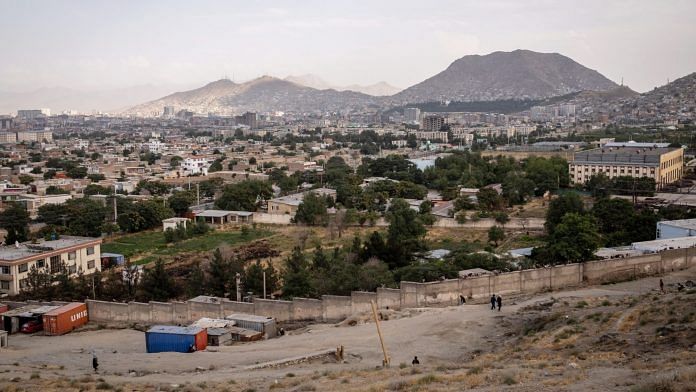India has sunk billions into Afghanistan, hedging its bets with a combination of soft and hard power.
Now, as nations desperately evacuate their troops, people and equipment, stunned by the Taliban’s quick takeover and attacks on those trying to flee, it’s worth examining what New Delhi’s strategic goals were and what the gains have been over the last two decades.
In 2015, Prime Minister Narendra Modi inaugurated the new Afghan Parliament house, built by India at a cost of $90 million, describing it as his country’s tribute to democracy in Afghanistan. The following year, Modi unveiled the renovated 19th century Stor Palace in Kabul, that was home to Afghan King Amanullah Khan during his reign in the 1920s. In 2016, he inaugurated the Salma Dam, a significant infrastructure undertaking in the western city of Herat that allows water access to the surrounding districts and the irrigation of thousands of hectares of land. With its investments in other highway and building projects, in total, India has put around $3 billion into Afghanistan, making it one of the largest regional donors to the country.
While the absolute amount may not be a huge sum compared to India’s $1.4 trillion domestic infrastructure promise this month, or even the hundreds of billions of dollars in losses from the teetering banking system that taxpayers have had to swallow, it’s hard to see what the policy achieved as images of the Taliban inside the parliament go viral.
The Modi government’s “Neighborhood First” foreign policy approach focuses on keeping the peace and maintaining mutually beneficial relationships in the region. It invests billions of dollars into countries from Bhutan to Nepal through its external affairs ministry’s budget and other departments. A key goal of this approach toward Afghanistan has been to ensure the country “doesn’t fall into the hands of Pakistan supported Taliban or some such force,” as former ambassador V.P. Haran put it in his speech at an Indian external affairs ministry lecture series in 2017. Friendship and goodwill aside, India has always known what’s at stake.
That fear has now become a reality India will have to reckon with. Its security establishment how has to assess whether Kashmir will once again be in play as it was three decades ago, when Islamist militants turned their attention to the region after the Soviet retreat from Afghanistan.
India’s investment hasn’t put it in a position to manage this risk, though, because New Delhi failed to create the strategic foothold it badly needs in Afghanistan. While Modi’s administration has long said such diplomacy isn’t about reciprocity, the reality is that as Afghanistan falls into chaos, India doesn’t have any leverage to ensure the country doesn’t become an even larger security threat across South and Central Asia.
On Thursday, India’s external affairs minister S. Jaishankar said India had only invested in its friendship with Afghan people and insisted it would get the full value in return. For now, he noted, India will take a “wait and watch” approach.
But if India’s strategy was meant to ensure it had a meaningful presence in a geographically strategic place, then it has fallen well short. Indeed, beyond its infrastructure investments, it has been unable to get significant projects off the ground, like the $11 billion Hajigak mine in Afghanistan’s Bamyan district. Friendship only gets you so far. Another key development, the Chabahar Port in Iran, was supposed to open up an important route to connect Afghanistan to Central Asia while bypassing India’s key rival, Pakistan. Already affected by Covid and the threat of more sanctions on Iran, the port is likely to face an even more difficult operating environment now the Taliban is in power.
A lesson from China may be in order here. The Belt and Road-style build up across Africa, Eastern Europe and places like Sri Lanka and the Maldives has ensured China’s heft is front of mind. In Afghanistan, despite putting in very little, Beijing ensured it had a hold on some mining rights there, even though there’s been no output because of security considerations. It assessed the risk-reward.
Part of China’s success has come from its strategic engagement with the Taliban. As a result, the world is now talking about how China could benefit from the recent turn of events, in the same breath that it mentions India’s geopolitical challenges.
It’s clear New Delhi failed to change its diplomatic posture in line with the shifting balance of power on the ground in Afghanistan. In a working paper looking at India’s options once the U.S. completed its troop withdrawal, the Carnegie Endowment for International Peace noted that “being more engaged in international negotiations, and even agreeing to talk to certain sections of the Taliban as part of a broader diplomatic initiative, are options that India can no longer afford to disregard.”
India’s policy in Afghanistan was mostly about soft power. Along with the parliament and the dam, several community projects and schools were set up, and of course, Afghans do love their Bollywood. Yet, India’s middling path has turned into a diplomatic dead end.—Bloomberg
Also read: How US not tied in Afghanistan could help India deal with Pakistan better



